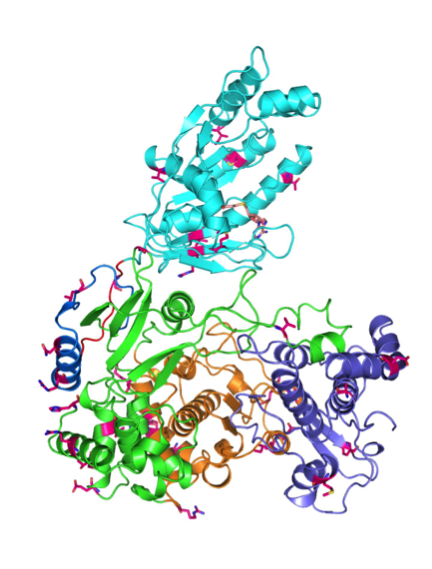Zika virus is a mosquito-borne infectious disease linked to certain birth defects in infants in South and Central America and the United States. A Lawrence Berkeley National Laboratory (Berkeley Lab) researcher, Banumathi Sankaran, worked as part of a multi-institutional team to map a key viral protein called NS5. Necessary to virus reproduction, NS5 contains two enzyme activities: one reduces the body’s ability to mount an immune response against infection and the other helps start the genetic replication process. The work was led by Indiana University’s Cheng Kao and Pingwei Li at Texas A&M University (TAMU).

This is the structure of the Zika virus protein NS5, which is key to the reproduction and spread of the virus. (Cheng Kao, Indiana University)
In a study published March 27 in Nature Communications, the team described the structure and function of these two enzyme active sites. They also showed comparisons between this protein and those from other related viruses that cause dengue fever, West Nile virus, Japanese encephalitis virus, and hepatitis C. These comparisons will help researchers as they search for possible compounds to halt the ability of the virus to reproduce.
Working with researchers from TAMU, Sankaran, a research scientist in the Molecular Biophysics and Integrated Bioimaging Division at Berkeley Lab, used X-ray crystallography to solve the atomic structure of NS5 in the Berkeley Center for Structural Biology at the Advanced Light Source (ALS). “The ALS was critical to the success of this project,” said Li. “The powerful beam and the sensitive detector on beamline 5.0.2 made it possible for us to obtain data on our poor quality crystals.”
Sankaran is in charge of the Collaborative Crystallography (CC) program at the ALS. Funded by the NIH, this program is a fast, reliable and transparent mail-in crystallographic service for the structural biology community. Since the mosquitos carrying the vector have been spreading into the Southern U.S., interest in studying the virus has increased and TAMU’s Li indicated that several groups currently are working on similar structural determination efforts. “Having access to state-of-the-art facilities provided by our Collaborative Crystallography program resulted in a rapid turnaround of this project,” according to Sankaran.
While the researchers have gathered a lot of information about how to target this protein, there are still puzzles remaining. “One of the most important unresolved questions about Zika NS5 is how it catalyzes the synthesis of RNA,” said Li. “We look forward to further studies and future collaborations, which will be invaluable for therapeutics discovery.”
Funding for this work was provided by the National Institutes of Health and the Howard Hughes Medical Institute. The ALS is a DOE Office of Science User Facility.
-Written by Lida Gifford
# # #
Lawrence Berkeley National Laboratory addresses the world’s most urgent scientific challenges by advancing sustainable energy, protecting human health, creating new materials, and revealing the origin and fate of the universe. Founded in 1931, Berkeley Lab’s scientific expertise has been recognized with 13 Nobel Prizes. The University of California manages Berkeley Lab for the U.S. Department of Energy’s Office of Science. For more, visit www.lbl.gov.
DOE’s Office of Science is the single largest supporter of basic research in the physical sciences in the United States, and is working to address some of the most pressing challenges of our time. For more information, please visit science.energy.gov.
